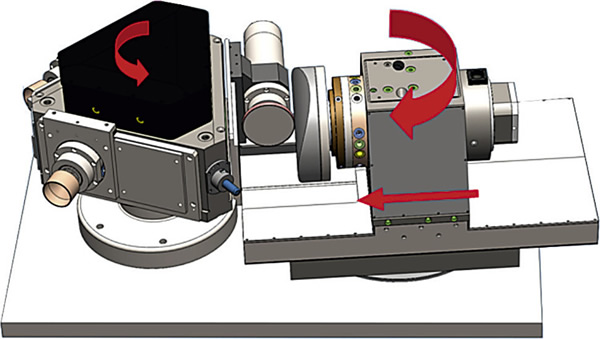Two rotary axes beat 2' of stacked linear axes. That’s the idea behind the new Twin Turret Generator (TTG) machine tools from Cranfield Precision. According to the company, the TTG machine offers a stiff and thermally stable design that improves machining precision and repeatability.
While conventional machine tools mainly use stacked linear axes to control motion, the TTG’s patented “twin-turret” design employs two stiff rotary axes and a short linear infeed axis to produce relative motion between the cutting tool and workpiece.


The TTG design from Cranfield Precision coordinates the motion of two rotary axes and a short linear axis for high-precision machining. Image courtesy Cranfield Precision.

To explain key differences between the TTG and conventional machines, Mark Stocker, Cranfield’s division manager for grinding, uses the concept of the stiffness and thermal “loop,” which refers to the path leading from the tool to the base of the machine and then back to the component being machined. “The longer that path is, and the more axes it runs through, the less stiff the loop will be,” Stocker said.
And that path is often very long. “If you look at a conventional machine,” Stocker said, “you’ve got lots of axes stacked one on top of the other, going down to a bed that could be a couple of feet from where the tool is.”
As for the thermal loop, he continued, all surfaces the loop runs through are exposed to grinding coolant, air temperature or both. So the longer the path traced by the thermal loop, the more susceptible the system will be to thermal distortions—and the more motion there will be between tool and component if the exposed surfaces heat up or cool down.
The TTG design boosts machine stiffness and reduces thermal distortions by shrinking the stiffness and thermal loop. In addition, the design includes a stainless steel tray surrounding the turrets that carries coolant to gutters around the machine. As a result, coolant never touches the machine base, which is “unique to our machine configuration,” Stocker said.
By contrast, he noted, it is impossible to prevent grinding coolant from touching the base of conventional machines. When coolant, warmed by the grinding process, touches the top of a machine base, the top warms up relative to the bottom, causing the base to bend.
Cranfield’s new machine tool comes in two versions: the TTG100 for parts up to 100mm (3.94") in diameter and the TTG400 for parts up to 400mm (15.75") in diameter. Key TTG capabilities cited by Cranfield include grinding to submicron tolerances, as well as milling, polishing, diamond turning and metrology.
For more information about Cranfield Precision, Bedford, U.K., visit www.cranfieldprecision.com or call +44 1234-312820. Or contact Fives Landis Corp., Hagerstown, Md., at (301) 797-3400.
Related Glossary Terms
- coolant
coolant
Fluid that reduces temperature buildup at the tool/workpiece interface during machining. Normally takes the form of a liquid such as soluble or chemical mixtures (semisynthetic, synthetic) but can be pressurized air or other gas. Because of water’s ability to absorb great quantities of heat, it is widely used as a coolant and vehicle for various cutting compounds, with the water-to-compound ratio varying with the machining task. See cutting fluid; semisynthetic cutting fluid; soluble-oil cutting fluid; synthetic cutting fluid.
- gang cutting ( milling)
gang cutting ( milling)
Machining with several cutters mounted on a single arbor, generally for simultaneous cutting.
- grinding
grinding
Machining operation in which material is removed from the workpiece by a powered abrasive wheel, stone, belt, paste, sheet, compound, slurry, etc. Takes various forms: surface grinding (creates flat and/or squared surfaces); cylindrical grinding (for external cylindrical and tapered shapes, fillets, undercuts, etc.); centerless grinding; chamfering; thread and form grinding; tool and cutter grinding; offhand grinding; lapping and polishing (grinding with extremely fine grits to create ultrasmooth surfaces); honing; and disc grinding.
- metrology
metrology
Science of measurement; the principles on which precision machining, quality control and inspection are based. See precision machining, measurement.
- milling
milling
Machining operation in which metal or other material is removed by applying power to a rotating cutter. In vertical milling, the cutting tool is mounted vertically on the spindle. In horizontal milling, the cutting tool is mounted horizontally, either directly on the spindle or on an arbor. Horizontal milling is further broken down into conventional milling, where the cutter rotates opposite the direction of feed, or “up” into the workpiece; and climb milling, where the cutter rotates in the direction of feed, or “down” into the workpiece. Milling operations include plane or surface milling, endmilling, facemilling, angle milling, form milling and profiling.
- polishing
polishing
Abrasive process that improves surface finish and blends contours. Abrasive particles attached to a flexible backing abrade the workpiece.
- stiffness
stiffness
1. Ability of a material or part to resist elastic deflection. 2. The rate of stress with respect to strain; the greater the stress required to produce a given strain, the stiffer the material is said to be. See dynamic stiffness; static stiffness.
- turning
turning
Workpiece is held in a chuck, mounted on a face plate or secured between centers and rotated while a cutting tool, normally a single-point tool, is fed into it along its periphery or across its end or face. Takes the form of straight turning (cutting along the periphery of the workpiece); taper turning (creating a taper); step turning (turning different-size diameters on the same work); chamfering (beveling an edge or shoulder); facing (cutting on an end); turning threads (usually external but can be internal); roughing (high-volume metal removal); and finishing (final light cuts). Performed on lathes, turning centers, chucking machines, automatic screw machines and similar machines.


